Link:Fish and Wildlife Service National Digital Library: Difference between revisions
From Indian River Lagoon Project
mNo edit summary |
No edit summary |
||
| (2 intermediate revisions by the same user not shown) | |||
| Line 18: | Line 18: | ||
The Maps collection is a selection of geospatial data and information used to visually represent conservation issues by analyzing and modeling for decision support. | The Maps collection is a selection of geospatial data and information used to visually represent conservation issues by analyzing and modeling for decision support. | ||
| | |Region=United States | ||
|Site Logo=Link-logo-united-states-fish-and-wildlife-service.gif | |Site Logo=Link-logo-united-states-fish-and-wildlife-service.gif | ||
|Screenshot=link-screenshot-fish-and-wildlife-service-national-digital-library.jpg | |Screenshot=link-screenshot-fish-and-wildlife-service-national-digital-library.jpg | ||
|Type=Archive | |||
|Topic=Educational Material | |||
|Subtopic=Wildlife | |||
|Poster=Admin | |Poster=Admin | ||
|Posted=20201108135140 | |Posted=20201108135140 | ||
}} | }} | ||
Latest revision as of 06:28, December 29, 2021
Fish and Wildlife Service National Digital Library
The United States Fish and Wildlife Service's National Digital Library is an archive of images, videos, documents, audio, and maps.
Videos
The Videos collection depicts the outstanding work of our FWS videographers who have produced outreach and instructional tools available for public access and depicts the outstanding work of the U.S. Fish and Wildlife Service and its conservation partners.
Documents
The Documents collection is a selection of reports, brochures, historic texts, oral history transcripts, and other texts.
Audio
The Audio collection is a selection of podcasts and audio files that provide insight into the U.S. Fish and Wildlife Service mission - "working with others to conserve, protect and enhance fish, wildlife, and plants and their habitats for the continuing benefit of the American people".
Maps
The Maps collection is a selection of geospatial data and information used to visually represent conservation issues by analyzing and modeling for decision support.
Posted By: AdminPost Date: 2020-11-08


